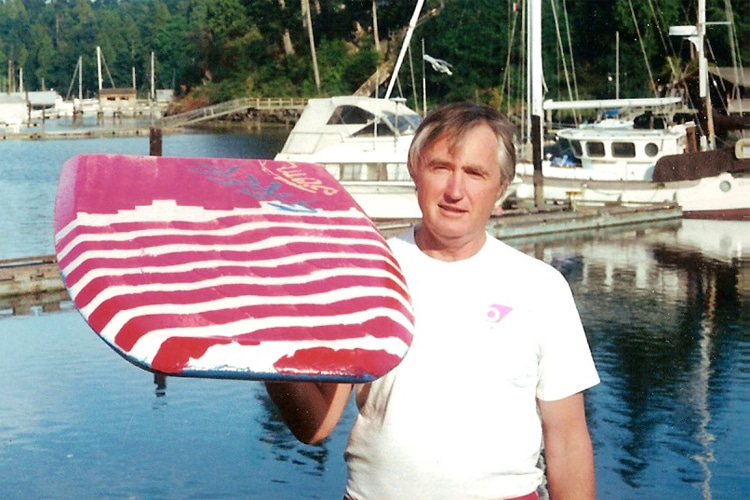Tom Morey needs no introduction. He's an icon and an idol for millions of bodyboarding enthusiasts. But our exclusive interview with the inventor of the boogie board goes way beyond his creation.
The year 2021 marks the 50th anniversary of Morey Boogie, the brand that gave birth to a new water sport.
Patti Serrano, the legendary bodyboarding contest organizer, historian, and passionate bodyboarder, is on a relentless mission to celebrate the birth of an object that changed many people's lives.
"Let's Boogie! 50th Anniversary" is a multidisciplinary project that involves online and offline events and exhibitions.
It is time to honor Tom Morey's legacy but also to project the future of the sport and the world we're living in.
SurferToday sat down with the surfer, engineer, inventor, musician, philosopher, and passionate wave-riding mogul.
Throughout our life, we won't be meeting many individuals like him. Morey is royalty in a palace of wisdom, logic, and timelessness.
Fasten your seatbelts. Get ready to savor the words - and the often controversial thoughts - Tom Morey has to share with each one of us.
And you won't believe it when you read about his groundbreaking yet magically simple wave pool concept.

What is the biggest challenge bodyboarding - and surfing - face in the next 50 years?
There are a lot of things. But we need to get out of our own way and scratch out the word "bodyboard" and "boogie board" and all that stuff.
We are surfers, and this is all about surfing, whether we're standing up on huge planks of yesterday or lying down on smaller things that fit the inside of the wave today.
So, that's the biggest challenge - to get out the terminology that we already abuse and to see that the name of the game is "the free ride."
As Miki Dora said, "Life is a waste of time, and surfing is a great way to waste it."
We're here on this planet, finding out as we grow up, thinking that we might be finding out why we're here if there is a why.
But from my standpoint, I buy into the fact that absolutely nothing other than we do is to make the best of what we do, to enjoy it, and to teach by it.
What does the future of surfing look like?
The future of surfing has got to go up and down.
There are better materials and better ways to make all the equipment, and there are better ways to use that equipment.
I have a grandson that's growing up in this sport.
At his age - at 10, 11, 12, 13, 14 - he's preoccupied - like the skateboarder down the street - with doing some complicated things that will give him attention, like doing an ollie.
He does it never out of 100. But every time he does it, everybody has to look at him.
This need for youth to get attention and be acclaimed, at his point in his age, holds everything back.
For the future of surfing, part of it is to get out of our own way and to quit trying to do these things so we look good or sound good, but rather for the enjoyment of it.
How we draw that line in our mind is pretty hard, no matter what you're doing.
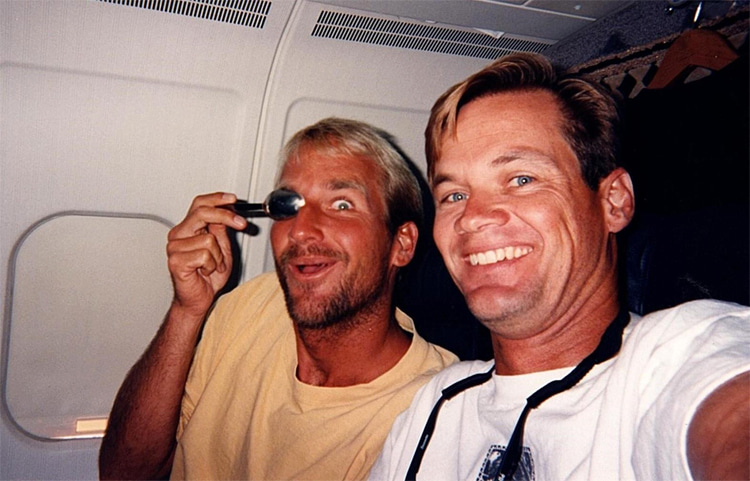
Do you think the shape of the bodyboard should evolve or change in any way?
Of course. The original one was fastened from a piece of foam that was plenty wide, about 24 inches [61 centimeters] wide, and 2.8 inches [7 centimeters] thick.
Then the skins went on it and were 1/8 inch, and there was some heat welding.
So, the typical thickness of the board is based on the manufacturing capability of the maker and has to do also with mailing the board.
One of the biggest breakthroughs in the Morey Boogie days was that I had some to mail, and I went to the post office, and the clerk said: "Well, let me see what you got."
I put it on the table in front of her, and she said: "Oh, it's too long. It's got to be in the double-digit price." It had got to be 20 or 30 dollars.
I said: "Is there some way for it to be any cheaper?"
She said: "If it's under 108 inches length and girth, it's a different price."
I asked: What is girth?"
Girth is you take this chain, and we wrap it around the board and measure that length. Then we add that to the length, and that is what is the terminated girth.
And I asked what the limit is, and she said it's got to be under 108 inches in length and girth.
And what's this one? "Oh, this one is too long - 112 inches," or something like that.
That's not too bad. I mean, this length was close to right, about four feet.
So, after experimenting, I found I could cut the shape to length down to 43.5 inches and basically 22 inches.
The thing came out at not just one, but four boards at about 108 inches long and girth.
It turned out that for $3.42, I was able to ship four boards anywhere in the United States, for example, from Puerto Rico to Guam.
An incredible breakthrough around which I changed the shape.
That has caused the shorter guys like Ben Severson and the taller guys like Mike Stewart at 6'2'' to recommend that length.
It was not based on shipping but on their preference and length.
So, that's one thing that will change the future - what lengths, what thicknesses, what widths make the most sense.
And we haven't determined that yet.
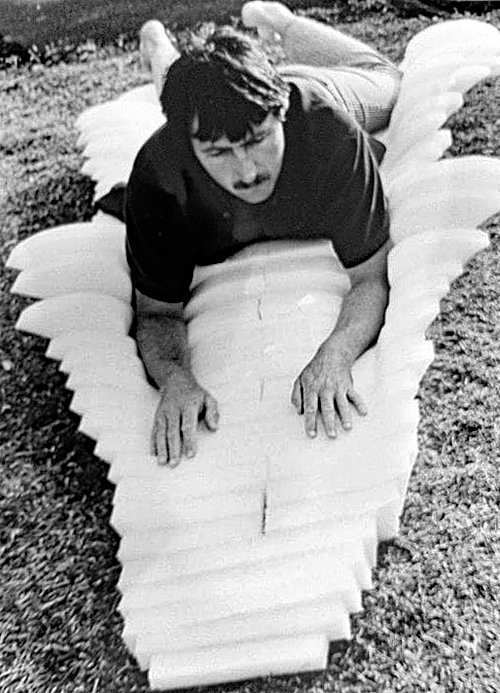
Do you think technology - chips, touchscreens, tracking devices - will be embedded in future surfboards and bodyboards?
That's a great question. Sure.
Fortunately, there are hobbyists that are exploring technology and every aspect of it.
So, here's this lightweight platform into which various devices can easily be embedded, including batteries, to power these things.
Tracking your board - where it is and what it's done, like people tracking with their wristwatches the heartbeat, how many steps they ran - this will be done, too.
What you want to do as a surfer, as a rider, will be up to you.
Things will be popular, and I'm popular to become unpopular for some to be a statistics geek and all that stuff.
You have all these predictions available at buoys at a distance from you, the measurement of the swell that's just passed under it...
What has been the most significant contribution the Morey Boogie brought to our planet?
I am no historian, but what I've seen is the smiling faces of hundreds, if not thousands of people, that I personally have seen.
They've come up to me and said, "Your boogie board changed my life," and they go on about how they did this and that, how they met their girlfriend or husband, and all these adventures in different countries.
So that is going to continue, I think, indefinitely, and not just on these states bordered on surfable oceans.
It's already happening.
Somebody has surfed - my preferred general term for what we do - every state in the country.
Soon, somebody will have surfed every country in the world.
Surfing began in my world with riding big planks that were 80-90 pounds in California but also continues - as you can see in the movie "Back To The Future," where the guy grabs onto the back of a truck passing by and he is skateboarding around.
Skateboarding came not too many years later, and it was just wonderful to be able to enjoy making a curving path on the sidewalks and on the streets.
Some of my greatest memories - 40 or 50 years ago - were when Hobie skateboard wheels had been developed.
A soft rubber that would grip and replace the steel wheels that were on the first skateboards, which I also enjoyed using.
But to have the grip of good polyurethane wheels under you and then trucks that would bank back and forth and would enable you to swivel your body to bank it, that gave a whole new dimension.
The moves that were developed for riding on those devices still hover in the surfing world in the water, as did the movements of several guys of that time.
Anyhow, one sport feeds the other.
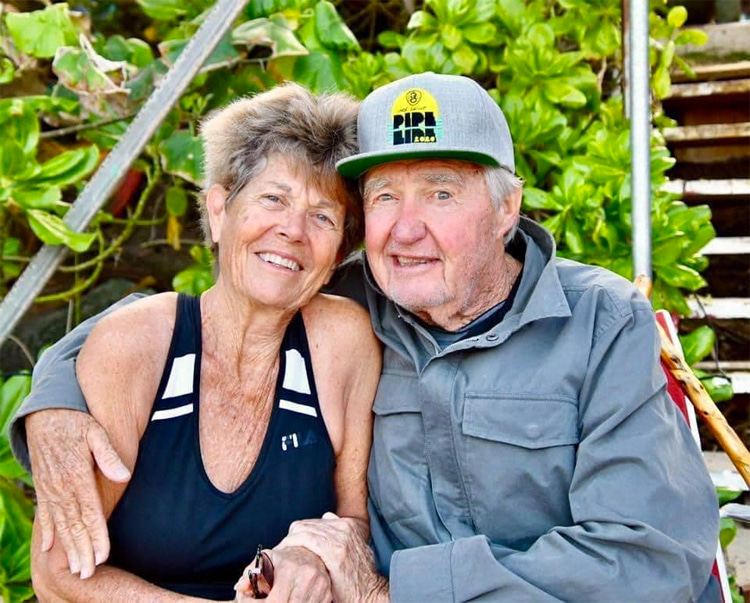
What should the surf industry do to reduce the environmental impact and footprint?
The skateboard, which dabbled into fiberglass and other materials, finally came down to wood.
Wood is nice. Its fragrance and the look of it, it's such a beautiful material.
For a long time, surfboards have been coming down in size and weight, and those have been thought important factors.
But we have already taken down surfboards to very short - and in my mind, too short.
The surfboard is something that could be a lot of fun all the time, but if it's too short to paddle out to the surf and to get a very long ride, then it's too short.
It's important to develop your ability to have fun on a surfboard at a longer and heavier size.
And heavier has been coming into vogue these days because too light - which I found out about 20 years ago - means that as soon as you unweight on your surfboard, the board slows down because it no longer has the momentum of you connected to the board because it is thick and sticky, but not to our viewpoint when we're drinking it.
But when we're riding through yards and yards of water on a wave, you can't make it no matter how you pump and jump because the board is just too sticky.
The wonderful breakthrough in the equipment is that at the surface, where we surf, there's another medium - air.
And every surfer should do this.
Get down under the boogie board or plank, put a face mask on, and when you're in the water, look up at the bottom of the board, and you'll see, sitting on the surface, between you and the board, big and tiny bubbles of air.
They look like silver.
If you then wiggle your board, you'll see that the bubbles' size increases and disperse.
If you wiggle it a lot, you will see that instead of just being held away from the water by 2, 3, 4, 5, or 6 percent air, the thing is held away from the water by 99 something percent.
Ninety-nine percent almost like that. They're almost all free from the water because of the air that gets entrapped there.
Now, to focus on the air entrapment aspect - that's a great place to spend some time with different texture surfaces on the materials, different pockets.
I had way back come up with golf ball pockets that hold air and keep it away from the surface.
But in between these golf ball pockets and the water, there would be another thin and flexible membrane glued here and there on the high points between the pockets, like 100 or 300 tiny trampolins on the [Morey Boogie Mach 8-TX] board.
The air that gets between the water and the trampoline is compressed and must decompress and is pushing back, so you're riding an air cushion that is tempered by a smooth surface.
So, there's all that kind of stuff.
I put this in an article 30 years ago in Surfer Magazine.
I imagined the guy mixing in his final gloss coat on the board. Actually, the final coat on a surfboard today is floor polish - Mop & Glo and that kind of stuff, which is aliphatic polyurethane.
So, you mix it with water and, with a sponge, you spread it all over your surfboard and clean its bottom and use mom's finish floor wax diluted with water, which gives it a certain sheen to the scratched bottom.
But you can also do that with a mixture of Alka Seltzer.
I enjoyed these things a lot with the boogie board.
I missed out on most of the development of the surfboard from the ancient days through the creation of the skegs by George Downing and those guys in Hawaii.
Downing put water skegs on the bottom of surfboards.
But I certainly caught up in later years with the boogie board and the surfboard that had evolved with Mike Doyle, who put in a rigid fiberglass stringer from the company that was making pultruded fiberglass near where he was working on the single ski.
Doyle was quite an innovator with colored wax, scented wax, single ski, and the soft surfboard.
I could've invented the soft surfboard.
We were making the foam he was using, and I was even making a paddleboard with a lateral fiberglass beam and a certain amount of flex, and instead, he made a surfboard by cutting the foam in two and making a stringer and putting it in there vertically.
And including the skeg as part of the structure. He built that in our shop with the help of Bobby Szabad.
I was coming back from Puerto Rico, and he said: "Hey Morey, you got to see what Doyle has done. Come on down here."
Doyle pulls up in his van with a huge smile, opens the back door, reaches in, and pulls a surfboard out, and throws it out onto the pavement, and it bounces around.
Oh boy.
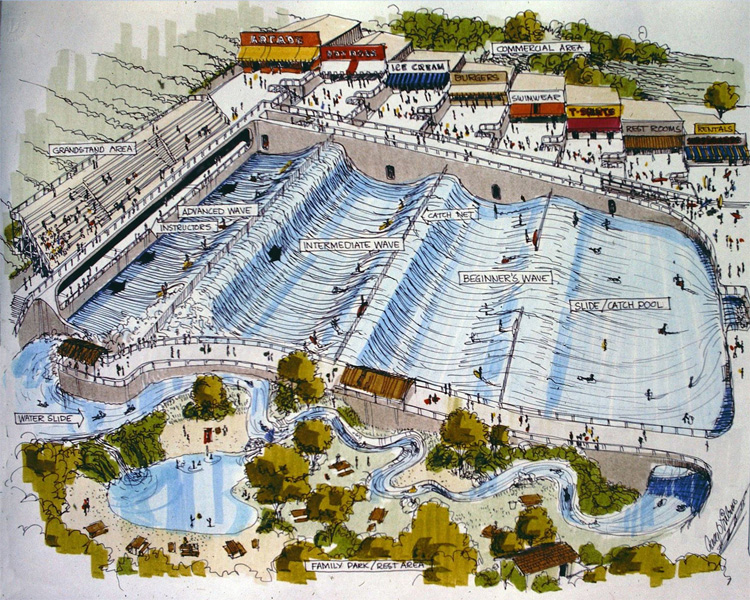
In the past, you've designed a wave pool concept. Today, artificial waves seem to be the future of inland surfing. What's right and wrong about the current wave pool technologies?
There are at least 100 wave pools in the world. And all of them are packed with people.
They all do the dumb simple stuff - generate the wave out in the deep water and have it finished in the shallow water.
And who finishes up in the shallow water? The rider.
And where do you finish up? Either standing up and falling into the shallow concrete, usually, or riding in and scraping your knees or hands on the rough bottom, which has been put in there, so people won't slip.
But the other way to do it is not in the wave pool where the wave ends.
You need a bigger wave pool with a deep area beyond the reef where you make a raised berm where you want the wave to break, and you make it taper from one side to the other, or from both sides to the middle of whatever, and let the wave form up, build up there, and after it forms and you have a chance to ride, then you finish off in deep water and continue on.
People make a wave pool, and they skimp on the size. It's so easy to make a pool, and no need to skimp on the size - make a big pool!
One of the things is to let it finish. The other thing is to recognize that the wave does not have to be breaking in order to be surfing.
On the contrary, it simply needs to be steep enough so that as the water rises and comes across this berm, it makes the water steep up enough so you can slide down the front of it.
Let's say you're making it with the wave cannon system, which I favor.
You fire the waves with compressed air from pipes that are facing toward your reef, and I was about to say to the shore, but that's not the way you build it.
If you have wave cannons in a lake, you can aim them across the shore or the beach. You can have a sandy, tapered beach, and instead of emulating Nature 100 percent, you don't fire the waves into the shore.
You fire from someplace near the shore, along the shore, and at an angle.
In effect, you'll have a sandy point break because the wave will peel along.
A wave cannon on a raft or platform that floats with wave-generating equipment - that's not difficult, expensive, heavy, or big.
You can put pipes underneath the raft and have them full of air, and then you compress that air and fire it off, generating your wave.
You do not use all pipes at once - use half of the pipes to generate the waves while the other pipes are being filled so that at any given time, there are enough pipes full of air to support the system while other pipes are firing waves off.
You can aim this thing along the beach at an angle, let it back off as it fires like a bazooka, kick back, and let it back be forward in terms of what you want to accomplish.
You can motor it into a better position and repeat that, going all around the lake.
And with the wave cannon system, you can be cleaning the water and get rid of the pollution, like in a couple of nearby lakes in the LA area.
They're OK, but they're not really OK because they've been neglected for a long time. God has given us natural lakes and rivers.
I use the term God, but I hate the shtick involved, so let's call it Nature, Providence, or Creation, the better word for me.
Creation provides us with everything and causes us to everything.
As an example, you're there a long distance away from me and - guess what - your body temperature is at 98.6 degrees, just like every human being on the planet.
All seven billion of us are at 98.6, and our hearts are pumping along pretty much at the same rate.
We are literally one energy spread out around this globe, interconnected but loose enough that we can spread out and enjoy different parts all at the same time.
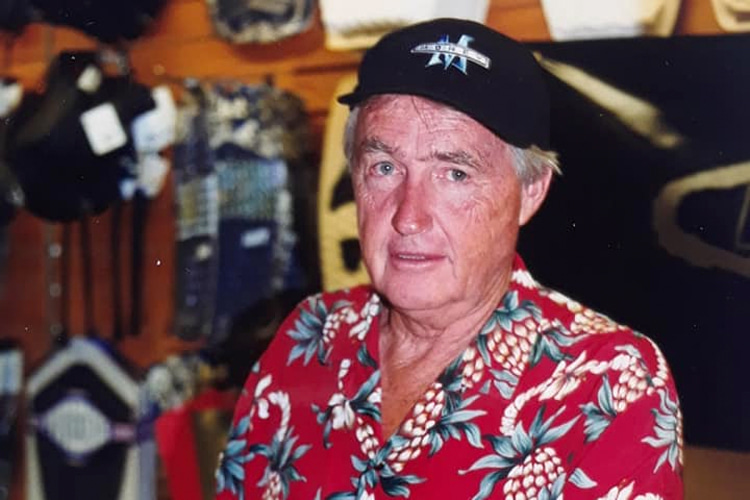
What has the mind of Tom Morey been working on lately?
Quite a few things all at once.
One of the biggest problems on the planet is garbage and sewage, and it's neglected because it's not something that our peers and parents want to encourage us to get involved with.
Youth wants to run and jump and play while the parents, they're fed up with us, and they kick us out, and we run off without the benefit of the elders.
We've lost the benefit of our elders.
We've got them sequestered where they won't cause any problems and where they're cared for, but they're not part of our society.
They need to be with us, to supervise us during this time period between when the elders were the parents and we're under the auspice, operating under the ones who have gone on.
The idea of the hereafter is questionable in the youth's mind, but it's not at all questionable in my mind.
The hereafter is simply another phase of existence.
We're like icebergs, ice cubes, and snowmen. And when a snowman breaks or melts, we pray for its soul.
It's like our lap. What happens to your lap when you stand up? There is no lap.
What happens to the hole in the doughnut when you eat the doughnut? Well, that's just BS talk.
We are all interconnected. We wonder if there's a hereafter when we die, are we obliterated?
You look at a worm, and then it makes a cocoon, and it spends some time there changing phase and comes out a moth or a butterfly.
The whole thing keeps morphing into something else.
The things I'm working on... You have poop and pee and sweat to deal with all the time.
And mankind and its cities and towns have all that too. And laundry dirt. And the detergents that are in the sewage.
Here in the US, we've got pretty good sewage, but you get out into other countries, and you can smell the sewage in the streets, along the gutters.
I've been to countries that were clean - Germany, England and France, and those European [countries].
But even in the movie "Matrix," the robot says the one thing it can't stand is the smell of humans. Humans stink.
We need to get rid of that. We need to teach ourselves and take proper care of ourselves.
We have all this washing and laundry to deal with, so it's hard to draw a line between man and surfing.
I'm sitting in the bedroom on top of a sheet that is cleaned and changed regularly, but in the water, when we get into the public territory, these things are not changed and cared for because we are all still so self-centered that we don't have time for that.
And it takes a lot of time and care to run a little town, village, household, and country, and this stuff is very important and is nothing that children pay attention to.
It bothers me, who have seen the voting age go down from 21 to 18, which was because the age at which you sent your precious son or daughter into battle from adult protection had dropped down to the draft age at 18, so if you're drafted at 18, you'll be able to vote.
The vote of an 18-year-old is nowhere near as good as a vote of a 19-year-old, let alone 29, 39, 49, 59, 69.
The idea of each person having one vote, no...
I'm at 85, and I don't want my 85-year-old experience offset by the experience of an 18-year-old kid.
His vote is not as valid as my vote because he hasn't been 19 yet, and I was 19 decades ago.
So, the elders need more votes; people that are qualified because of their jobs and their education need more of a vote than those who are not.
That whole thing needs to be revolutionized before we get very far.
And the size of cities and towns needs to be limited, as well as the building of society.
Surfing, which is outside of society, can make minor strides, but it still has got to be limited by property owners, police, and politicians that are building their measures for the general population.
And so we surfers, for the foreseeable future, will be limited in our progress by the allowances of society.
You can't go to the beach of your choice and do the things you used to be able to do.
I used to be able to go surfing naked at Trestles in 1956. I can't do that.
At Rincon, not many years ago, it was cold, I gathered together some twigs and driftwood, and I built a fire down there.
Some guy came rushing up to me and said: "You can't have a fire here. This is Rincon Beach."
And I lost my board one day at San Onofre, and I didn't have a leash on, and a guy got my board inside and waited for me to come in.
I was halfway to the beach, and as I got in, he pushed the board into the shore and chewed me out for not having a leash.
Well, I wanted to chew him out for being there.
I'm not there with a leash to protect the other surfers, and when you're on a wave, and somebody's paddling out, we think that we need to make allowances for him or her to paddle out.
No.
I didn't come here to make allowances for beginners that don't know they're paddling out in the way the surfers are coming.
I am there to surf and do what the place is for. I'm surfing.
So, we have political problems with those who have been here before, and those who are just coming here, and those who are coming out of their mother's care, and just getting out of their diapers, and want to be cared for at the beaches.
No.
There's got to be places where you can go that are dangerous, and you can take your chances.
We have to keep hospitals and doctors under check so that they don't have us having our dental check every six months.
"No, let's make it three months. Let's make it every month so that we can pay for this expensive dental equipment that we bought that cost millions of dollars."
We have a lot to change in society before surfing has got to change a whole lot.
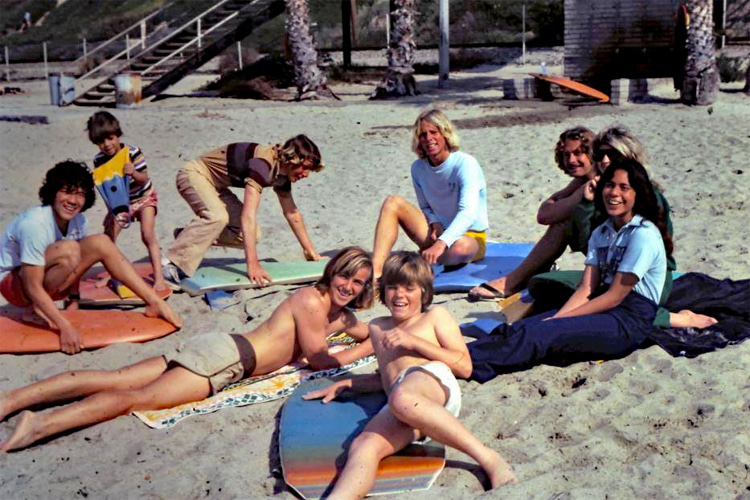
What does the engineer Tom say to the surfer Morey?
I have ego and experiences, and I have desires.
I cherish the great moments - that's about all you can get. There's a John Coltrane song called "Great Moments."
No matter what it is, it's not all great moments.
There are peaks in the waves and life and times that are really special, and you can't have them all the time because, otherwise, nothing is special.
So, I'm very thankful for the equipment changes that have occurred.
And the soft surfboard was one of the great ones, and the boogie board was one of the great ones because you don't get hurt so much.
And because they're not so expensive.
But let's talk about edibility, disposability, and safety, and let's look at improvements in each of those three arenas.
Where is the edible surfboard? Where is the edible boogie board? Where is the softer, less dangerous stand-up paddleboard and surfboard?
Right here in front of us, the thing that's lagged behind is the swim fin.
And the thing that has lagged behind the understanding of everybody is the importance and availability of magnets.
Magnetism for your swim fins, for example.
You're wearing a pair of shoes or flippers or something.
We all have found it necessary, practical, and prudent to have protection on our feet so that when we're walking on the beach, we don't step on a lit cigarette that somebody has casually tossed away.
You've been burned by that, and there are prohibitions for having glass bottles on the beach - and that's very good.
So, the surfer's brain has to be aware of the need to be cautious.
When you go to the beach, there are many things that can hurt you - clams, broken glass underwater, and trash of all kinds floating on the water.
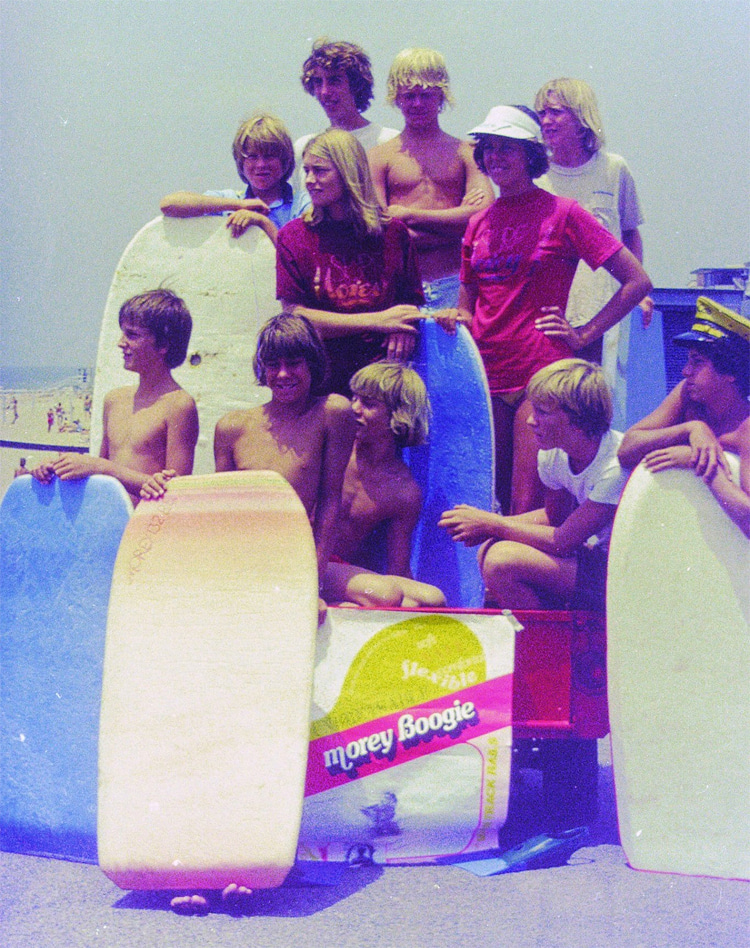
What does the spiritual philosopher Y say to the surfing world?
I got it down into two words - surf and life.
You know, you decide to go to the beach for some enjoyment because you understand that waves may be up at your local beach.
This was before we had predictions like we have today.
Then you go down there and have to have developed decent tolerance and personality in order to get along surfing.
Because if people don't like you, if you are obnoxious in any way, it's got to show up, and it's got to dampen your enjoyment because you're not going to get the waves.
And if you've been belligerent about any aspect of life, it's got to come out when you're surfing because you're going to assume things that are not true and going to get you in some kind of trouble or out of the pocket.
You go to the beach as an experienced surfer and look at all the people that have no experience or very little experience, and they're sitting out there, and they're looking around, and as far as I'm concerned, they're just like everybody else, but the experience levels are vastly different.
The guy sitting right next to us is catching wave after wave, and you're not getting anything.
Well, he knows how to read the ocean, he reads the waves and how they move through the water, and each wave that moves through the water reveals the depths and conditions directly below.
They're tracing - you can watch a wave rise and fall, and you know that the bottom contour is also rising and falling, rock or sand - and you can see ahead.
I keep coming back to surf life. Surfing requires great observation, as sailing does.
Sailboarding pays close attention not only to the waves but also to the wind, wind direction, and power, the texture of the water in the area that you're heading towards.
But we are alive in a living entity.
The living entity observes itself and utilizes its own mechanics and its own forces in order to have a living environment.
So, we're here to enjoy, and the one thing that a friend told me under special conditions was: "Enjoy." And I've taken that to heart.
And that is what we're here for because we're the only game in town.
We're alive, and this whole playground is here.
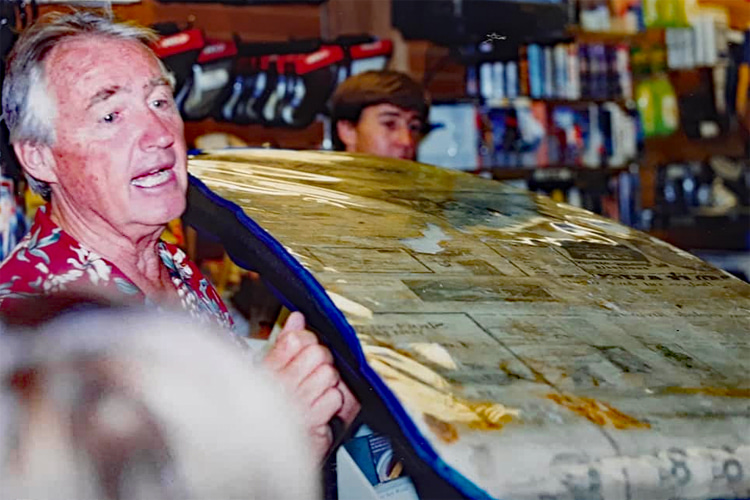
Extra, Extra: Deep Thoughts
Seek, and you'll find; knock, and the door will be opened to you.
This is easy. These are teachings from the Bible. I am not properly wording them, but you understand what I'm saying.
We are connected to the entire reality, and in one way, we're connected by what comes out of your own mouth and goes into your own ear.
I have been a man that prays a lot. But I don't believe - I just know.
Prayer is the essential connection. You have to ask.
I've got a place on my arm that itches, so Tom Morey's brain sends a message from my other hand to my fingernails, and they scratch - because of the prayer coming from the part that needs to be scratched.
Mankind is like that, too. We don't understand that we're all connected physically - my hairdo, my fingernail polish, my shape, my lipstick.
Stop bringing attention to our tiny selves and try getting some kudos for just being here.
